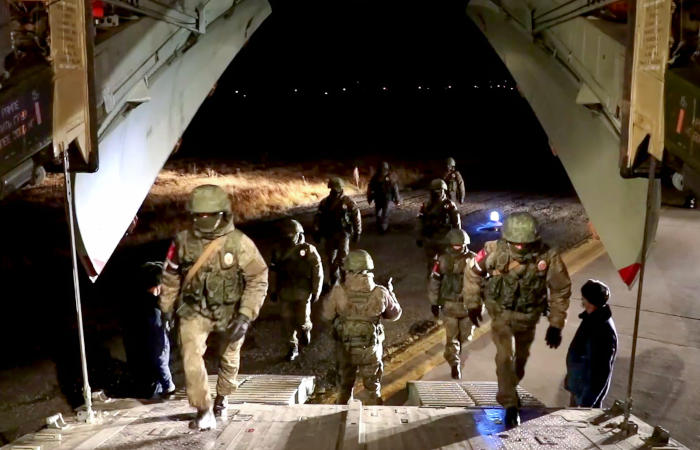Russia started deploying peacekeepers to the war-ravaged enclave of Nagorno-Karabakh, also known as Artsakh, after imposing a ceasefire on Armenian forces to withdraw from positions claimed by arch-enemy Azerbaijan and bombed since September.
Armenian Prime Minister Nikol Pashinyan appealed to the nation saying the deal brokered by Russia’s President Vladimir Putin was “unspeakably painful for me personally and all of us,” prompting thousands of Armenians to march on the parliament building in Yerevan, calling the premier a ‘traitor’.
Pashinyan said the agreement followed “an in-depth analysis of the military situation” that has seen Azeri forces closing in on Stepanakert, the region’s main city.
He said the agreement was “the best possible solution to the current situation”.
The capture of the strategic town of Shushi by Azeris appears to have been a turning point. It sits on a mountaintop overlooking Stepanakert, the Armenian enclave’s capital.
Russia has a defence pact with Armenia, but throughout the conflict, Moscow said it would intervene only if Azerbaijan invaded the territory of the Republic of Armenia. Baku has been careful not to do so.
Hours before the agreement was signed, Azerbaijan apologised to Moscow and offered to pay compensation after it admitted shooting down a Russian helicopter by mistake.
Two crew members died in the incident and a third was injured.
Reuters reported, “the deal is likely to be seen as a sign that Russia is still the main arbiter in a region it regards as its own backyard, though the scale of Turkish involvement remained unclear and Ankara’s interest in the region has sharply increased.”
“In accordance with the statement of the President of the Republic of Azerbaijan, the Prime Minister of the Republic of Armenia and the President of the Russian Federation, from 6:00, November 10, 2020, the Russian Federation will start deploying a peacekeeping contingent in the zone of the Nagorno-Karabakh conflict in parallel with the withdrawal of the Armenian armed forces,” the Interfax news agency reported the Russian Defence Ministry as saying.
The ministry said the Russian contingent will comprise the 15th motorised rifle (peacekeeping) brigade of the Central Military District airlifted from the Ulyanovsk military base in western Russia. The troops will stay for five years.
The first transport plane with a military police unit flew from Russia to the zone of the Nagorno-Karabakh conflict at dawn on Tuesday, according to a video that was distributed by the Russian Defence Ministry.
The footage showed the loading of vehicles and military police units with machine guns on board the aircraft.
Russia said it will send a peacekeeping contingent of 1,960 servicemen, 90 armoured personnel carriers and other equipment to be based in Stepanakert, the capital of Nagorno-Karabakh.
Mixed reactions
The three leaders adopted a statement, according to which from midnight Monday Moscow time, a complete ceasefire and all hostilities in Nagorno-Karabakh were announced and units of the armed forces of Azerbaijan and Armenia to stop at their positions.
Russian peacekeepers will be deployed along the Nagorno-Karabakh conflict zone with Azerbaijan and beside the ‘Lachin corridor’ that links Artsakh with the Republic of Armenia, territories it gained in 1991-1993, followed by the first ceasefire in 1994.
Since then, peace talks initiated by Russia, the U.S. and France in 1992, known as the OSCE Minsk Group, have failed several times, with Azerbaijan increasing its aggression on Nagorno-Karabakh and Armenia proper since 2016 to claim back territories it lost to the ethnic local Armenian population.
After several skirmishes in August, Azerbaijan’s forces unleashed a military push in September with the help of Turkey, using mainly Turkish and Israeli-built drones that bombed civilian targets, hospitals, churches and schools.
So far, the people of Artsakh, assisted by volunteers from Armenia and the Diaspora, have counted about 3,000 dead and wounded while the casualties on the Azeri side are believed to be triple that number with Turkey sending some 2,000 mercenaries, mainly from Syria, to the front-line.
Earlier it was reported that hundreds of people, dissatisfied with the decision of the Prime Minister of Armenia, who agreed to a ceasefire and the introduction of Russian peacekeepers into Nagorno-Karabakh, gathered outside the government building in the centre of Yerevan and clashes broke out between police officers and demonstrators.
The building of the Armenian government was seized by the demonstrators on Monday night.
As reported by the Interfax correspondent, several dozen people smashed furniture, equipment, smashed doors, and windows, some of them entered Pashinyan’s office.
Al Jazeera’s Osama Bin Javaid, reporting from Baku, the capital of Azerbaijan, said news of the agreement brought people onto the streets to celebrate despite a curfew.
The deal includes Armenia handing back some territories on the edge of the Nagorno-Karabakh region, while Azerbaijan will halt its push towards Stepanakert, he added.
“The reaction to this declaration of an end to the war in Armenia has been greeted with what appears to be absolute disgust and despair,” said Robin Forestier-Walker, Al Jazeera’s correspondent in Tbilisi, in neighbouring Georgia.
“There is just a sense of disbelief that somehow this was the only option for Armenia, to effectively admit defeat, and to sign this agreement with Azerbaijan, brokered by Russia, that brings this war to an end, but effectively allows Azerbaijan to claim almost complete victory.”









